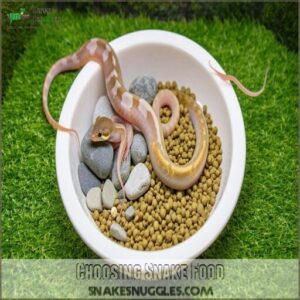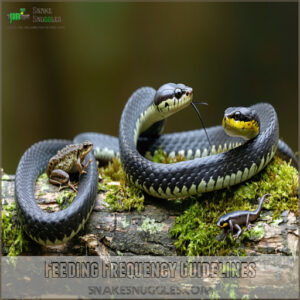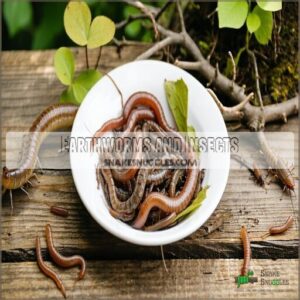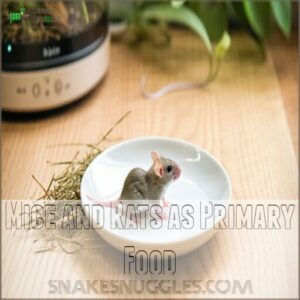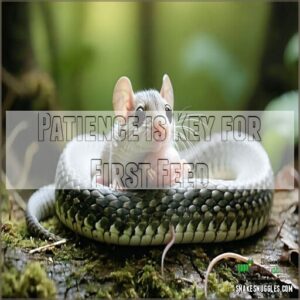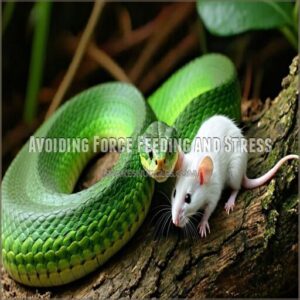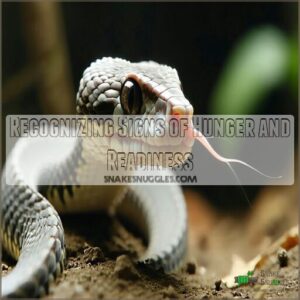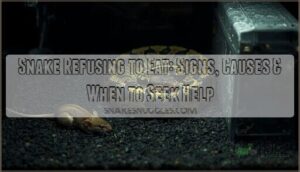This site is supported by our readers. We may earn a commission, at no cost to you, if you purchase through links.

It’s important to choose the right prey to guarantee they thrive. For most species, pinkie mice are an excellent starting point, providing essential nutrients and calories.
You’ll want to evaluate your snake’s species-specific needs and adjust prey size accordingly. Earthworms and small lizards can also be great options.
As you explore the field of snake nutrition, remember that a balanced diet is key to a healthy, happy snake – and there’s more to learn about creating the perfect feeding schedule for your new pet.
Table Of Contents
- Key Takeaways
- Choosing Snake Food
- Feeding Frequency Guidelines
- Prey Types and Options
- Environmental Factors Matter
- Feeding Hatchlings Successfully
- Frequently Asked Questions (FAQs)
- How do you feed a hatchling snake?
- How do you feed a corn snake?
- What do baby corn snakes eat?
- What do Baby hognose snakes eat?
- Do hatchling snakes eat mice?
- How do you feed a snake in a tank?
- How Can You Tell the Age of a Baby Snake?
- What Temperatures Do Baby Snakes Need to Thrive?
- How Do Wild Baby Snakes Find Food and Water on Their Own?
- What Health Problems Are Common in Baby Pet Snakes?
- Conclusion
Key Takeaways
- You’ll want to choose the right prey for your hatchling snake, like pinkie mice, to guarantee they thrive and get the essential nutrients they need.
- It’s crucial to consider your snake’s species-specific needs and adjust the prey size accordingly, as some species may require different types of food, like earthworms or small lizards.
- You’ll need to establish a feeding schedule based on your snake’s age, with younger snakes eating more frequently, and monitor their growth and health to adjust the schedule as needed.
- Creating a suitable environment, including a proper temperature gradient, balanced humidity, and a secure enclosure, is key to supporting your hatchling snake’s appetite and overall health, and will help them grow into a healthy, happy adult.
Choosing Snake Food
Choosing the right food for your hatchling snake is essential for its growth and health.
You’ll need to take into account its species, nutrient needs, and the size and type of prey to make sure proper nutrition is achieved.
Species-Specific Diet Considerations
Each snake species has unique dietary needs.
Research your hatchling’s species-specific diet to match their natural prey. Garter snakes thrive on fish and earthworms, while corn snakes prefer pinky mice.
A proper baby snake diet provides reptile hatchling nutrition. Use a snake nutrition guide to plan feeding strategies, and consider dietary supplements for calcium and vitamins when necessary.
Understanding snake species diet is important for providing the right nutrients for your hatchlings.
Nutrient Requirements for Hatchlings
When planning a baby snake diet, focus on protein needs and mineral balance.
Hatchling snake food, like pinky mice, meets caloric intake and nutrient absorption requirements. Reptile hatchling nutrition benefits from small, manageable prey.
Avoid overfeeding; stick to prey no larger than the widest part of the snake’s body. Vitamin supplements may help, but consult a snake nutrition guide first.
For peak health, consider hatchling care tips to review when selecting the best food for your baby snake.
Prey Size and Type Selection
Once the yolk sac is depleted, choosing the right prey size and type is key for hatchling snake feeding.
The best food for hatchlings matches their girth and supports their nutritional needs. Understanding snake diet basics is essential for their health.
Stick to these tips:
- Offer pinky mice no wider than 1.5x the snake’s body width.
- Try live prey first, then frozen-thawed.
- Introduce prey variety like lizards or frogs to ensure a balanced diet.
Feeding Frequency Guidelines
Feeding your hatchling on the right schedule is key to supporting its growth and overall health.
By understanding age-based guidelines and adjusting as needed, you’ll provide your baby snake gets the nutrition it requires.
Age-Based Feeding Schedules
Feeding hatchling snakes isn’t one-size-fits-all.
Age impacts how often they eat.
Hatchlings thrive on small, frequent meals to match their rapid growth rates.
Use this feeding chart:
| Age | Frequency | Prey Size | Notes |
|---|---|---|---|
| 0-1 month | Every 5-7 days | Pinky mice | Match girth of snake |
| 1-3 months | Every 7 days | Slightly larger pinkies | Monitor growth closely |
| 3-6 months | Every 7-10 days | Fuzzy mice | Adjust as snake develops |
| 6-12 months | Every 10 days | Larger fuzzies | Watch for overfeeding |
| 1+ year | Every 10-14 days | Juvenile mice | Assess activity levels |
Stick to this hatchling snake diet plan for steady development.
It is crucial to match the girth of the snake and monitor growth closely to ensure the snake’s health and avoid overfeeding.
Monitoring Growth and Health
To ensure proper hatchling snake care, focus on growth tracking and health checks.
Regular weight monitoring helps gauge snake development and ensures a proper nutrient balance.
If your baby snake seems sluggish or isn’t growing, adjust its diet or environment.
Snake hatchling feeding isn’t one-size-fits-all, so keep an eye on behavior and body condition for best hatchling snake health.
Understanding snake feeding health is critical for making informed decisions about your pet’s diet and environment.
Adjusting Feeding Frequency as Needed
As you monitor growth and health, adjust feeding cycles based on your hatchling snake’s needs.
A consistent feeding schedule supports snake development and nutrient balance.
If your baby snake seems sluggish or refuses food, reassess its diet plan.
Health checks can reveal underlying issues.
Stick to feeding frequency guidelines, but remain flexible—every hatchling is unique and may require tweaks.
Prey Types and Options
Concerning feeding hatchlings, choosing the right prey is essential for their growth and health.
From insects to small rodents, each option has specific benefits and must match the snake’s size and species needs.
Earthworms and Insects
If you’re considering earthworms and insects for feeding baby snakes, focus on size and nutrition.
Worm size should match the snake’s girth, ensuring easy digestion.
Bug variety, like crickets or mealworms, offers balanced Insect Nutrition.
However, avoid insects with hard shells that may harm hatchlings.
For safe hatchling snake care tips, always check for potential Insect Allergy reactions before introducing live prey.
When selecting live earthworms, understanding live earthworm care is essential for the health of the snakes.
Frogs and Tadpoles as Prey
If your hatchling snake prefers an amphibian diet, frogs and tadpoles can be excellent options.
These aquatic prey items offer great frog nutrition and tadpole benefits for growth. However, wild-caught prey may carry parasites, so prioritize safety.
Always match prey size to your snake’s girth. Feeding baby snakes amphibians mimics their natural diet, aiding reptile hatchling food adjustments.
Understanding snake feeding habits is important for providing the right nutrients.
Mice and Rats as Primary Food
Switching from frogs to mice and rats, you’ll find they’re a staple for snake hatchling care.
Pinky mice are ideal for feeding baby snakes due to their size and Prey Nutrition.
Here’s how to get it right:
- Pick pinky mice matching your snake’s girth.
- Offer live prey first, then frozen-thawed.
- Avoid oversized prey.
- Prioritize Nutrient Balance. Understanding proper mouse food sources is essential for their health, and choosing the right mouse food is crucial.
Environmental Factors Matter
Your hatchling’s environment plays a huge role in its appetite and overall health.
Proper temperature, humidity, and a secure enclosure make sure your baby snake feels safe enough to eat and thrive.
Temperature Gradient Importance
A proper temperature gradient is essential for your hatchling snake’s health.
It supports digestion, metabolism, and natural behaviors by letting them move between warm basking spots and cooler areas.
Use reliable temperature control tools to maintain 85-90°F on the warm side and 75-82°F on the cool side.
This setup complements your snake hatchling diet plan effectively, ensuring a healthy environment through a proper temperature gradient.
Humidity Levels and Snake Health
Maintaining proper humidity levels is key to baby snake care. Too low, and shedding issues or dehydration arise; too high, and scale rot or respiratory health problems can occur.
Aim for balanced humidity to support snake hydration and overall health.
Here’s how:
- Use a hygrometer for monitoring.
- Mist the enclosure sparingly.
- Add a water dish.
- Adjust ventilation.
- Check daily to ensure the environment remains suitable for the snake’s health, promoting proper humidity levels.
Enclosure Setup and Snake Wellbeing
When setting up your snake habitat, consider ventilation systems, substrate options, and temperature control to maintain a healthy environment.
Manage humidity levels and create an ideal enclosure setup for your baby snake, supporting their diet plan and feeding schedule with a well-designed space.
Proper snake enclosures require careful planning and research on snake enclosure designs to meet the specific needs of your pet, including a suitable temperature control and healthy environment.
Feeding Hatchlings Successfully
You’ll need to provide the right food and environment for your hatchlings to thrive, and that starts with understanding their unique nutritional needs.
By following some key guidelines and tips, you can help your baby snakes grow and develop into healthy, happy adults.
Patience is Key for First Feed
When feeding hatchlings, patience is key.
Consider these First Feed Tips:
- Research snake nutrition
- Choose appropriate prey size
- Wait for natural hunger
- Avoid force feeding
- Monitor hatchling care.
This maintains a healthy baby snake feeding schedule and diet plan.
Avoiding Force Feeding and Stress
When feeding hatchlings, patience is key.
Avoid force feeding, as it causes stress.
Significant weight loss can necessitate force feeding a ball python.
Separate hatchlings, provide a warm enclosure, and consider scent transfer to encourage eating.
Follow the hatchling snake feeding schedule and choose the right prey size to guarantee a stress-free experience for your baby snake.
Recognizing Signs of Hunger and Readiness
You’ll notice your hatchling’s restlessness and increased activity.
Watch for tongue flicking, prey scent interest, and upright body posture.
Here are signs of hunger:
- Restlessness
- Increased activity
- Tongue flicking
- Prey scent interest, to adjust the hatchling snake feeding schedule and baby snake feeding tips.
Frequently Asked Questions (FAQs)
How do you feed a hatchling snake?
You’ll feed hatchling snakes small prey, like pinkie mice, every 5-7 days, handling them gently, and providing a warm, secure environment to encourage eating and support their rapid growth.
How do you feed a corn snake?
You’ll want to offer your corn snake small, thawed prey like pinkie mice, about 1-5 times its girth, every 5-7 days, for best growth and nutrition, don’t overfeed.
What do baby corn snakes eat?
You’ll typically offer baby corn snakes small prey like pinkie mice, which provide essential nutrients for growth and development, and are a staple food for many hatchling snakes initially.
What do Baby hognose snakes eat?
You’ll be amazed, baby hognose snakes devour tiny prey like pinkie mice, fuzzies, or small lizards, and earthworms, fueling their rapid growth and development with precise, nutrient-rich meals.
Do hatchling snakes eat mice?
You’ll find that hatchling snakes often eat small mice, such as pinkie mice, as their first meals, which provides essential nutrients for growth and development.
How do you feed a snake in a tank?
You place prey in the tank, using tongs to simulate movement, and let the snake hunt, ensuring a stress-free feeding experience in its naturalistic environment.
How Can You Tell the Age of a Baby Snake?
Silently studying snake scales, you can estimate a baby snake’s age by measuring its length and weighing it.
As growth rates vary by species, and consulting a reptile expert is recommended, this method requires careful consideration of the species-specific factors that influence snake growth, making reptile expert consultation crucial for accurate age estimation.
What Temperatures Do Baby Snakes Need to Thrive?
You’ll want to maintain a temperature range of 80-85°F for your baby snakes, with a slight drop to 75-80°F for the cool side.
To make sure they thrive and grow healthily, it’s crucial to adhere to this temperature range, as baby snakes require specific conditions.
How Do Wild Baby Snakes Find Food and Water on Their Own?
Can you imagine venturing into the wild without guidance?
You’d likely follow instincts, using senses to hunt small prey like insects, worms, and tiny vertebrates for survival, just like wild baby snakes do, and this is a natural process.
What Health Problems Are Common in Baby Pet Snakes?
You’ll commonly see issues like metabolic bone disease, respiratory infections, and dehydration in baby pet snakes, often due to improper feeding, temperature, or humidity conditions.
Conclusion
You’ll feed a million snakes in your lifetime, but choosing the best snake food for hatchlings is essential.
Selecting the right prey, like pinkie mice, guarantees they thrive.
Remember, a balanced diet is key to a healthy snake, so research the best snake food for hatchlings to guarantee a happy pet.
- https://kb.rspca.org.au/knowledge-base/what-should-i-feed-my-reptile/
- https://www.anapsid.org/hatchlin.html
- https://snakesnuggles.com/snake-feeding-guide-for-beginners/
- https://www.reptileforums.co.uk/threads/new-snake-not-feeding-a-very-wordy-article-on-getting-hatchlings-going.909055/
- https://www.quora.com/How-much-should-an-adult-corn-snake-be-fed-per-feeding

